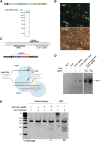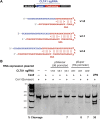RNA-programmed genome editing in human cells
- PMID: 23386978
- PMCID: PMC3557905
- DOI: 10.7554/eLife.00471
RNA-programmed genome editing in human cells
Abstract
Type II CRISPR immune systems in bacteria use a dual RNA-guided DNA endonuclease, Cas9, to cleave foreign DNA at specific sites. We show here that Cas9 assembles with hybrid guide RNAs in human cells and can induce the formation of double-strand DNA breaks (DSBs) at a site complementary to the guide RNA sequence in genomic DNA. This cleavage activity requires both Cas9 and the complementary binding of the guide RNA. Experiments using extracts from transfected cells show that RNA expression and/or assembly into Cas9 is the limiting factor for Cas9-mediated DNA cleavage. In addition, we find that extension of the RNA sequence at the 3' end enhances DNA targeting activity in vivo. These results show that RNA-programmed genome editing is a facile strategy for introducing site-specific genetic changes in human cells.DOI:http://dx.doi.org/10.7554/eLife.00471.001.
Keywords: Cas9; Human; endonuclease; genome editing.
Conflict of interest statement
MJ, Founder of Caribou Biosciences and member of its scientific advisory board. Has filed a provisional patent related to this work.
JD, Founder of Caribou Biosciences and member of its scientific advisory board. Has filed a provisional patent related to this work.
The other authors declare that no competing interests exist.
Figures




Comment in
- doi: 10.7554/eLife.00563
References
Publication types
MeSH terms
Substances
Grants and funding
LinkOut - more resources
Full Text Sources
Other Literature Sources
Molecular Biology Databases
Research Materials

